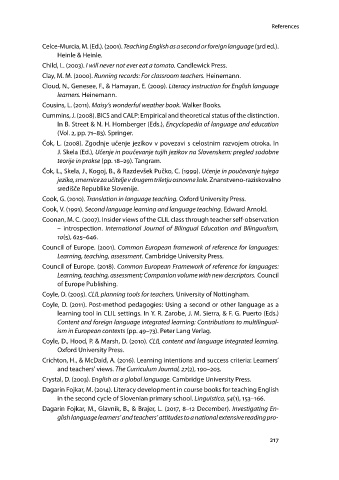Page 217 - Teaching English at Primary Level: From Theory into the Classroom
P. 217
References
Celce-Murcia,M.(Ed.).(2001).TeachingEnglishasasecondorforeignlanguage(3rded.).
Heinle & Heinle.
Child, L. (2003). I will never not ever eat a tomato. Candlewick Press.
Clay, M. M. (2000). Running records: For classroom teachers. Heinemann.
Cloud, N., Genesee, F., & Hamayan, E. (2009). Literacy instruction for English language
learners. Heinemann.
Cousins, L. (2011). Maisy’s wonderful weather book. Walker Books.
Cummins, J. (2008). BICS and CALP: Empirical and theoretical status of the distinction.
In B. Street & N. H. Hornberger (Eds.), Encyclopedia of language and education
(Vol.2,pp. 71–83).Springer.
Čok, L. (2008). Zgodnje učenje jezikov v povezavi s celostnim razvojem otroka. In
J. Skela (Ed.), Učenje in poučevanje tujih jezikov na Slovenskem: pregled sodobne
teorije in prakse (pp. 18–29). Tangram.
Čok, L., Skela, J., Kogoj, B., & Razdevšek Pučko, C. (1999). Učenje in poučevanje tujega
jezika,smernicezaučiteljevdrugemtriletjuosnovnešole.Znanstveno-raziskovalno
središče Republike Slovenije.
Cook, G. (2010). Translation in language teaching. Oxford University Press.
Cook, V. (1991). Second language learning and language teaching. Edward Arnold.
Coonan, M. C. (2007). Insider views of the CLIL class through teacher self-observation
–introspection. International Journal of Bilingual Education and Bilingualism,
10(5), 625–646.
Council of Europe. (2001). Common European framework of reference for languages:
Learning, teaching, assessment. Cambridge University Press.
Council of Europe. (2018). Common European Framework of reference for languages:
Learning, teaching, assessment; Companion volume with new descriptors. Council
of Europe Publishing.
Coyle, D. (2005). CLIL planning tools for teachers. University of Nottingham.
Coyle, D. (2011). Post-method pedagogies: Using a second or other language as a
learning tool in CLIL settings. In Y. R. Zarobe,J. M.Sierra, &F.G.Puerto (Eds.)
Content and foreign language integrated learning: Contributions to multilingual-
ism in European contexts (pp. 49–73). Peter Lang Verlag.
Coyle, D., Hood, P. & Marsh, D. (2010). CLIL content and language integrated learning.
Oxford University Press.
Crichton, H., & McDaid, A. (2016). Learning intentions and success criteria: Learners’
and teachers’ views. The Curriculum Journal, 27(2), 190–203.
Crystal, D. (2003). English as a global language. Cambridge University Press.
Dagarin Fojkar, M. (2014). Literacy development in course books for teaching English
in the second cycle of Slovenian primary school. Linguistica, 54(1), 153–166.
Dagarin Fojkar, M., Glavnik, B., & Brajer, L. (2017, 8–12 December). Investigating En-
glishlanguagelearners’andteachers’attitudestoanationalextensivereadingpro-
217

